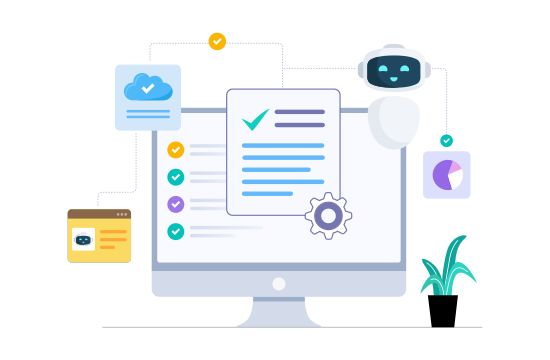TL;DR:
Self-healing test automation ensures that automated tests adapt to changes in the application without manual intervention. Using AI/ML, tests detect broken elements, update locators automatically, and prevent failures. This reduces maintenance overhead, boosts test reliability, and accelerates software delivery.
The world of software testing is evolving fast. While automation has already replaced many repetitive manual tasks, traditional test automation still struggles with one big challenge: broken or flaky tests whenever the app changes.
That’s where self-healing test automation comes in: a smart solution that automatically adapts to changes, prevents test failures, and keeps your delivery timelines on track.
With the right tools, like Testsigma, teams can unlock a smoother, faster, and almost worry-free testing experience. Think of it as giving your tests a little superpower; they fix themselves so you don’t have to.
Table Of Contents
- 1 What Is Self-Healing Test Automation?
- 2 Why Do Tests Break So Often?
- 3 How Does Self-Healing Work In Test Automation?
- 4 Key Benefits Of Self-Healing Automation
- 5 Self-Healing In Practice
- 6 Self-Healing in Testsigma
- 7 Self-Healing Vs. Traditional Test Maintenance
- 8 Challenges And Limitations Of Self-Healing
- 9 Best Practices For Implementing Self-Healing Tests
- 10 Future Of Self-Healing Test Automation
- 11 FAQ
What is Self-Healing Test Automation?
Self-healing in test automation is like a “smart autopilot” for your tests. Imagine Google Maps rerouting you instantly when there’s a roadblock, and your journey continues without stopping.
Similarly, when an element in your app changes, self-healing tests detect it, adjust automatically, and keep your test suite running smoothly.
At its core, self-healing automation solves a common problem in traditional test automation: broken locators. Programs identify web elements using attributes like Name, ID, XPath, or CSS.
When these attributes change, test scripts fail, causing entire test cases to collapse. Self-healing ensures these issues are resolved automatically.
It also empowers teams to adopt a Shift Left approach in Agile, making testing faster, more efficient, and boosting overall productivity. A growing number of tools like Testsigma leverage AI and Machine Learning to support self-healing automation.
Why Do Tests Break so Often?
Even the best automated test suites fail due to:
- Flaky tests from timing or environment issues
- Dynamic locators and UI changes, which break hard-coded selectors.
- Maintenance overhead, where updating test scripts manually becomes time-consuming and expensive.
This creates a pain point for teams: test automation promises efficiency, but broken tests slow delivery and increase costs.
How Does Self-Healing Work in Test Automation?
Every test case relies on locators (ID, Name, XPath, CSS) to verify UI elements. But as apps evolve, these locators change – causing tests to fail.
Self-healing automation steps in by detecting the new locator and updating scripts automatically, so your tests stay stable without manual fixes.
Here’s a simple breakdown of the mechanism:
Locators → AI/ML → Healing rules → Updated tests
Let’s walk through each stage:
Locator Intelligence and AI Matching
Tests use locators (ID, Name, XPath, CSS) to find UI elements. If a locator breaks, AI analyzes historical data and finds the closest match.
Idea: Think of it like your phone recognizing a friend’s face even after a haircut; it uses multiple cues, not just one.
Automatic Updates to Scripts
Once the element is found, the tool updates the locator automatically. This can happen in real-time or be suggested for approval later.
Idea: Think autocorrect fixing typos so the sentence still makes sense.
Reporting and Alerts
The tool logs healed elements, frequency of changes, and confidence scores. Testers stay in control with dashboards and alerts.
Idea: Healing is traceable: testers can review, confirm, or roll back changes anytime.
Key Benefits of Self-Healing Automation
Instead of wasting hours on maintenance, self-healing automation helps QA teams focus on innovation. The benefits span efficiency, stability, and faster delivery.
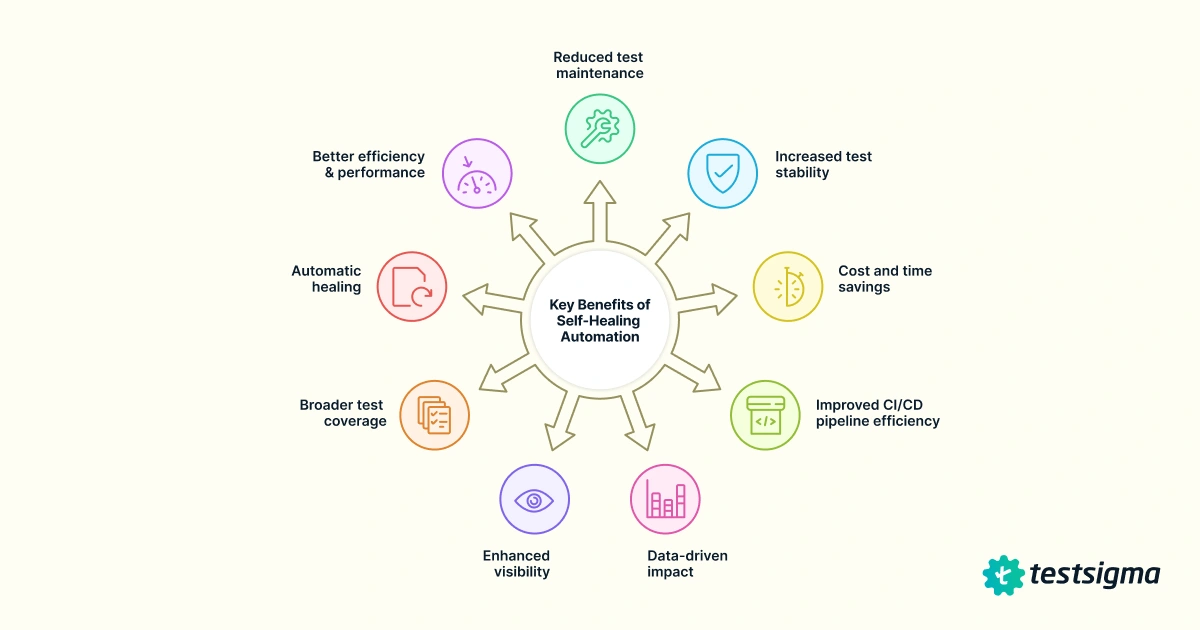
Here’s how:
- Reduced test maintenance: Cuts down the time spent fixing broken scripts.
- Increased test stability: Prevents test flakiness by ensuring more reliable and consistent results.
- Cost and time savings: Automates tedious, repetitive fixes so teams can focus on high-value tasks.
- Improved CI/CD pipeline efficiency: Fewer broken builds keep the pipeline running smoothly.
- Data-driven impact: Studies show self-healing can reduce test failures by up to 90%.
- Enhanced visibility: Provides insights into test stability, application issues, and component performance.
- Broader test coverage: Minimizes redundant code, enabling teams to cover more scenarios.
- Automatic healing: Object locators update themselves, leading to fewer failed test cases.
- Better efficiency & performance: Speeds up the testing process while improving overall software quality.
Self-Healing in Practice
From e-commerce sites to SaaS dashboards, self-healing adapts to UI changes, reducing manual effort and preventing test failures.
Let’s look at a few examples:
1. E-commerce website updates
Imagine an online store where the product page layout changes, say, the “Add to Cart” button moves or gets renamed.
In a traditional setup, this would instantly break the checkout test flow, forcing testers to rewrite locators.
With self-healing, the automation tool detects the updated element and adjusts the locator automatically, keeping the checkout tests running smoothly.
2. Mobile app UI changes
Mobile apps are updated frequently, and even a small tweak, like renaming “Login” to “Sign In” or shifting a button’s position, can break dozens of test cases.
Self-healing steps in by mapping the old locator to the new one, so the scripts don’t fail. Testers get stable results without chasing every small UI adjustment.
3. Enterprise SaaS updates
For SaaS products, dashboards and analytics panels undergo regular redesigns or new feature additions. Normally, this halts regression testing because locators tied to changed UI elements stop working.
Self-healing ensures the tests adapt in real time, so regression runs continue without interruption, even when the UI evolves week to week.
Before vs. after self-healing
Even small UI tweaks can break traditional tests, yet with AI-driven self-healing in tools like Testsigma, scripts recover instantly, minimizing downtime and manual effort. Here’s a quick comparison to show the difference before and after self-healing:
| Scenario | Before self-healing | After self-healing |
| UI changes | A single UI change could break multiple tests. Testers had to manually inspect scripts, find broken locators, and rewrite them. | The automation tool auto-detects the updated locators and heals the scripts automatically. |
| Impact on delivery | Releases slowed down due to repeated manual fixes. | Tests pass seamlessly, saving hours of maintenance and keeping delivery pipelines on track. |
Self-Healing in Testsigma
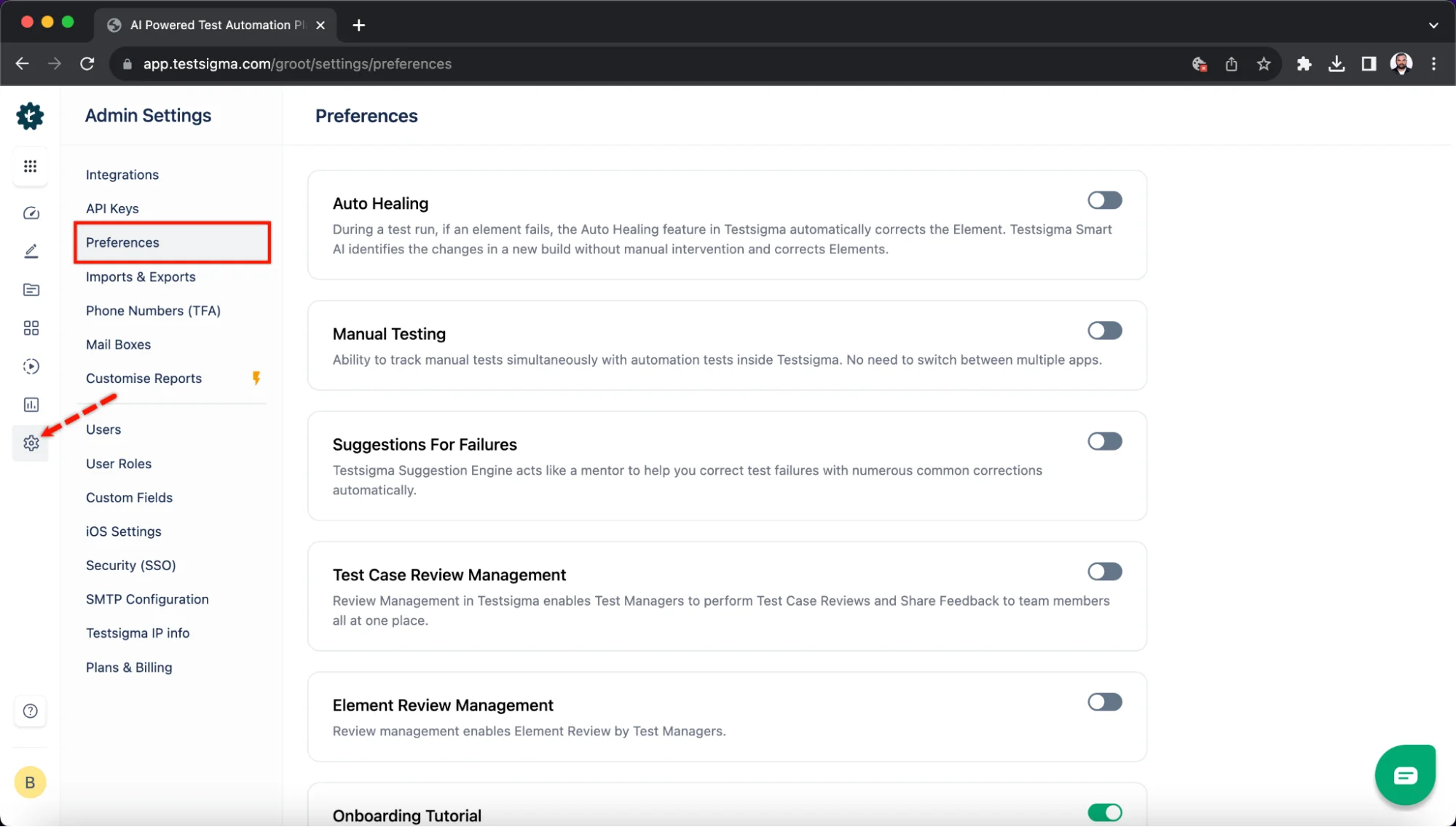
The number of changes in testing code often mirrors the updates developers make to an application. For instance, if the ID or class attributes of a web element change, the corresponding automated test scripts also need to be updated.
While this may seem simple, frequent changes across an application can consume significant time and effort for testers.
Testsigma leverages AI to transform failing locators into stable tests, without any manual intervention. The AI detects abnormalities in existing test scripts and automatically fixes them without human intervention.
No-Code AI for Locators
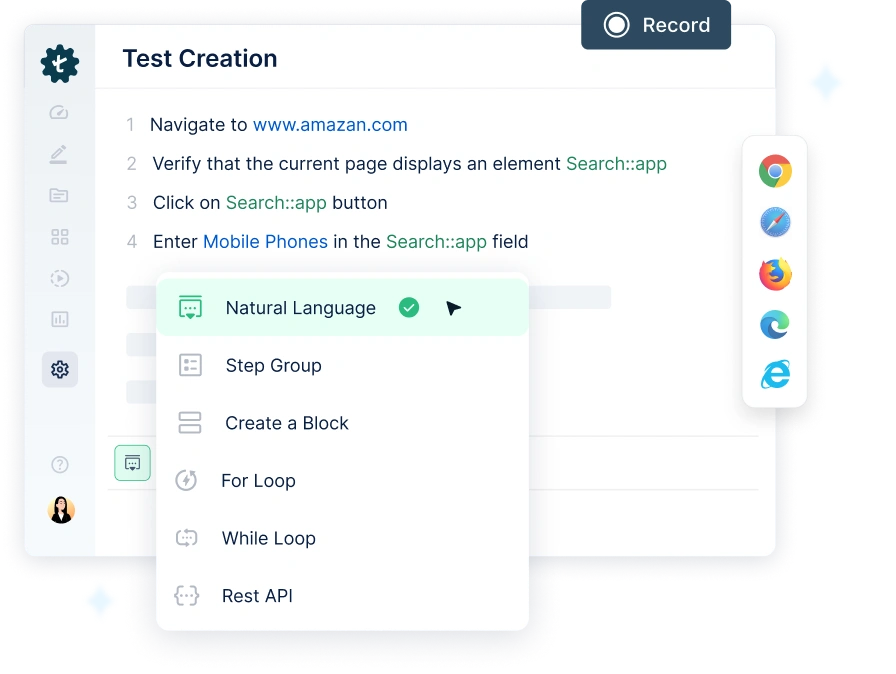
With Testsigma, you don’t need to write a single line of code to identify or update locators. The AI automatically detects changes in UI elements and updates your tests accordingly.
This is ideal for codeless automation teams, allowing them to focus on testing logic rather than debugging broken locators. Even non-technical team members can manage and maintain stable tests effortlessly.
Continuous Healing in CI/CD
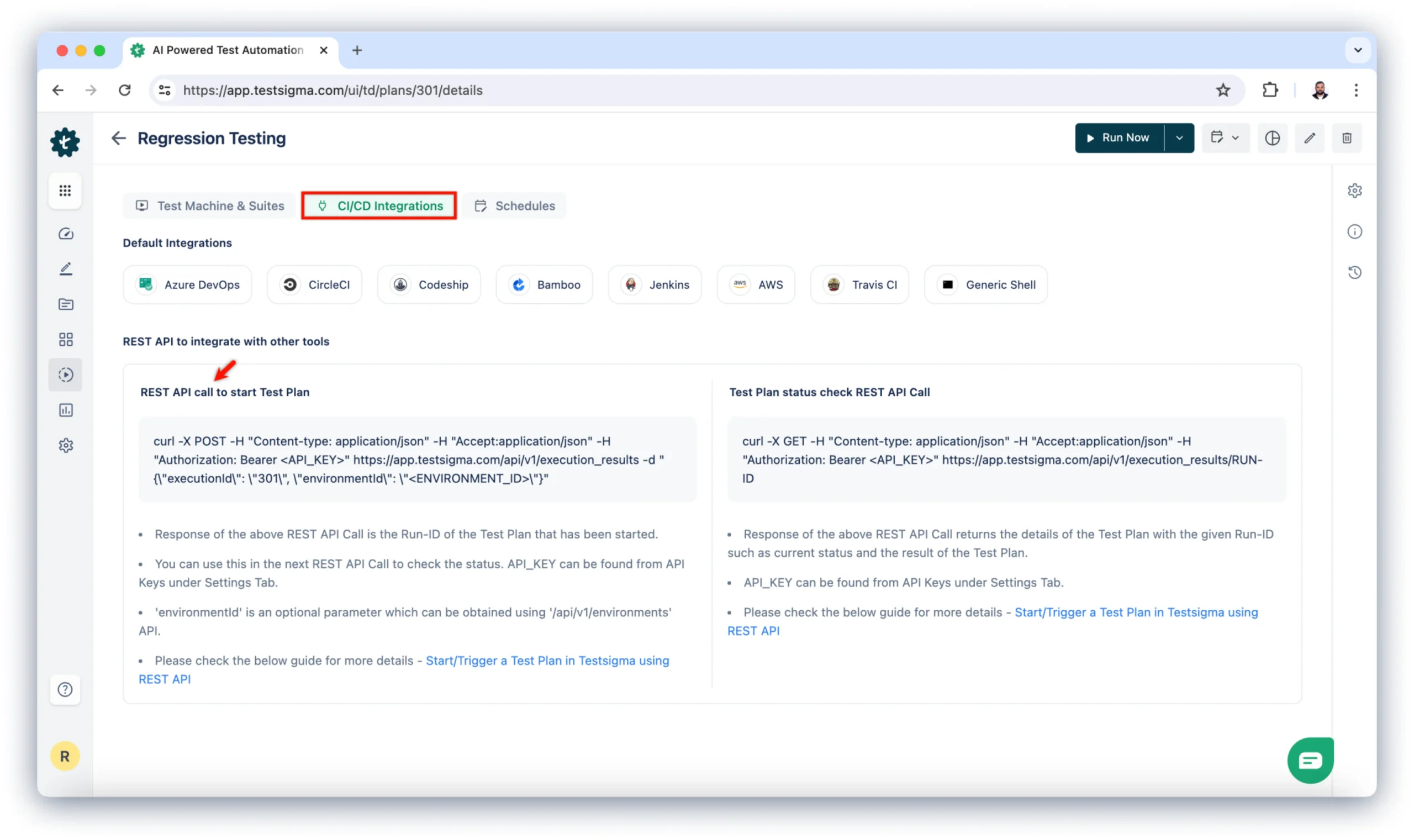
Testsigma integrates seamlessly into your CI/CD pipelines, meaning self-healing happens automatically whenever tests run. When developers make frequent UI changes, the AI updates locators in real time, preventing test failures.
This keeps your automation resilient, ensures continuous delivery pipelines don’t break, and reduces manual maintenance during every deployment.
Visibility through Dashboards
Testsigma provides full transparency into all self-healing activities. Dashboards show which elements were healed, how often they change, and the impact on overall test coverage.
Teams can track trends, validate critical workflows, and review AI-driven changes, giving confidence that automated tests remain accurate and reliable without losing human oversight.
Self-Healing Vs. Traditional Test Maintenance
Self-healing automation transforms how teams maintain tests. Let’s compare it with the traditional approach to see the difference in action.
| Feature | Traditional Test Maintenance | Self-healing Test Maintenance |
| Locator Updates | Manual | Automatic with AI |
| Test failures | Frequent | Rare |
| Maintenance effort | High | Low |
| CI/CD integration | Risky | Seamless |
| Coverage | Limited | Expanded |
Challenges and Limitations of Self-Healing
No technology is perfect. Highlighting the potential pitfalls of self-healing helps teams make informed decisions.
- Over-healing risk: AI might occasionally select the wrong element.
Solution: Keep a human-in-the-loop for critical workflows and review healed elements via dashboards to ensure accuracy. - Initial setup effort: Implementing self-healing requires planning and baseline test data.
Solution: Start with critical flows first and gradually expand coverage, documenting baseline test cases to make AI learning more effective.
Best Practices for Implementing Self-Healing Tests
Implementing self-healing tests effectively requires a thoughtful approach. Following proven practices helps teams maximize benefits while minimizing risks and surprises during automation.
- Begin small, test, and expand.
- Monitor auto-healing logs for anomalies.
- Validate critical workflows manually when needed.
- Use dashboards for insights and decision-making.
Future of Self-Healing Test Automation
The landscape of test automation is evolving rapidly, and self-healing is no exception.
Recent research highlights how AI and ML are set to revolutionize self-healing test automation, making tests more adaptive and resilient.
As applications grow more complex and release cycles accelerate, future-ready automation will need to not only fix broken tests but also anticipate changes and adapt intelligently.
Here’s what’s on the horizon:
- LLM-driven healing: Large Language Models (LLMs) will understand the context and expected behavior of UI elements, allowing tests to self-correct more intelligently and reduce false positives.
- AI in testing: AI will not only fix broken locators but also suggest new test cases, optimize workflows, and propose fixes proactively, making test automation more proactive than reactive.
- Adaptive CI/CD pipelines: Fully autonomous pipelines will detect changes, heal tests, and run validations without human intervention, enabling truly touchless testing for faster and safer releases.
With these advancements, Testsigma is well-equipped to take advantage of AI and generative technologies, helping teams keep pace with the evolving landscape of test automation.
By integrating such capabilities, teams can stay future-ready while maintaining resilient, high-quality software delivery.
Start self-healing automation with Testsigma today – Sign up for Free
FAQ
Self-healing test automation automatically detects broken locators or UI changes and updates test scripts to prevent failures, keeping your tests stable and reliable.
Yes, when implemented correctly, self-healing reduces test flakiness and maintenance overhead, though critical workflows may still benefit from occasional manual validation.
AI analyzes test failures, identifies updated locators, and applies changes automatically, ensuring tests adapt to evolving application elements without human intervention.
Several tools offer self-healing capabilities, including Testsigma, Mabl, Functionize, and Testim, with varying levels of AI-driven automation.
Enable the Auto-Healing feature in Testsigma’s settings, run your tests, and let the AI detect and fix UI changes automatically while monitoring results via dashboards.

